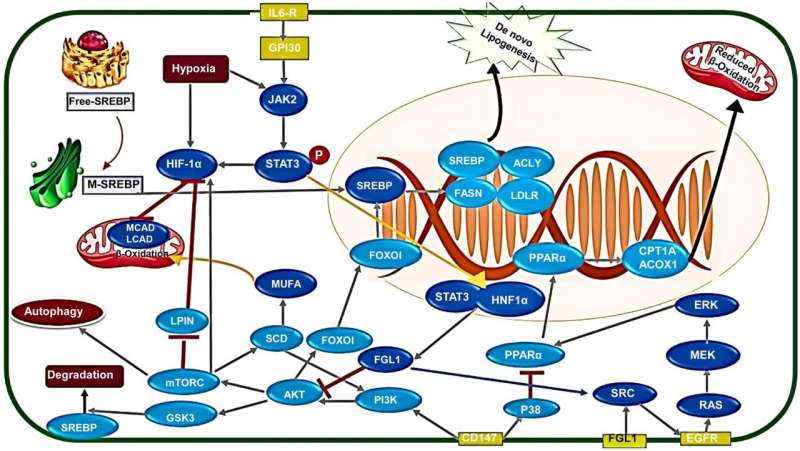This article has been reviewed according to Science X's editorial process and policies. Editors have highlighted the following attributes while ensuring the content's credibility:
fact-checked
proofread
Role of fibrinogen-like protein 1 in tumor recurrence following hepatectomy

Hepatocellular carcinoma (HCC), a leading cause of cancer-related mortality globally, exhibits a dismal five-year survival rate of only 18%. Major contributing factors to HCC include viral hepatitis infections and nonalcoholic fatty liver disease.
Despite advancements in chemotherapy and radiotherapy, which have shown efficacy in controlling HCC, these treatments are often accompanied by severe side effects. As a result, surgical interventions such as liver transplantation and partial hepatectomy (PH) remain the primary therapeutic strategies, particularly in the early stages of HCC.
Among these, PH is crucial due to the scarcity of suitable organs for transplantation. However, a significant drawback of PH is the high rate of tumor recurrence, with about 70% of patients experiencing recurrence within five years.
The process of liver regeneration following PH is driven by the activation of various molecular pathways involving growth factors, endocrine effectors, and liver cells. While this regeneration is essential for liver recovery, it also provides an environment conducive to the growth of residual microtumors, leading to recurrence and metastasis. Targeting specific molecules that play a role in both liver regeneration and tumor recurrence could be key to reducing the high recurrence rates seen post-PH.
Fibrinogen-like protein 1 (FGL1) is a critical player in this context. FGL1, also known as Hepassocin or HFREP-1, is a 68-kDa hepatokine predominantly expressed in the liver and pancreas. It is involved in numerous physiological processes, including glucose and lipid metabolism, liver regeneration, and potentially the lipid metabolic reprogramming of cancer cells. Interestingly, while FGL1 expression is elevated in regenerative hepatocytes, it is typically downregulated in malignant cells, particularly in HCC.
FGL1's expression is regulated by transcription factors such as HNF-1α and STAT3, as well as inflammatory effectors like TGF-β and IL6. This dual role of FGL1, promoting liver regeneration on one hand and potentially facilitating tumor recurrence on the other, makes it a molecule of significant interest in HCC research.
FGL1 activates several proliferative pathways, including the EGFR/Src/ERK pathway, which plays a crucial role in the transition of hepatocytes from the G0 to the G1 phase of the cell cycle. This transition is essential for liver regeneration but can also promote the transformation of susceptible cells into cancerous ones. Additionally, the loss of the FGL1 allele on chromosome 8, a region associated with tumor suppression, can activate the PI3K/Akt/mTOR pathway, contributing to HCC development.
FGL1 is also involved in other carcinogenic processes, including hypoxia, epithelial-mesenchymal transition, immunosuppression, and drug resistance, particularly to sorafenib, a common chemotherapeutic agent used in HCC treatment. These multifaceted roles of FGL1 highlight its potential as both a facilitator of liver regeneration and a contributor to tumor recurrence.
Beyond its roles in proliferation and metabolism, FGL1 also has significant immunological implications. It acts as an immunosuppressive receptor through its interaction with lymphocyte activation gene (LAG)-3. This interaction can lead to resistance to immunotherapy, posing additional challenges in the treatment of HCC. The immunosuppressive properties of FGL1 further complicate its role in liver regeneration and cancer recurrence.
Given its complex roles, FGL1 presents a promising target for therapeutic intervention aimed at preventing HCC recurrence post-hepatectomy. Developing targeted therapies that can effectively differentiate between the regenerative and oncogenic activities of FGL1 is crucial. Such therapies could potentially inhibit the recurrence of HCC without compromising liver regeneration.
Future research should focus on elucidating the detailed mechanisms through which FGL1 operates in both normal and malignant cells. This understanding could pave the way for the development of novel therapeutic strategies that specifically target FGL1's oncogenic pathways while preserving its regenerative functions.
This review highlights the significant role of FGL1 in liver regeneration and HCC recurrence post-hepatectomy. By understanding the pathways and processes regulated by FGL1, researchers can develop targeted therapies to improve outcomes for HCC patients undergoing partial hepatectomy.
Continued research into FGL1's functions and interactions is essential for translating these findings into clinical applications, potentially reducing the high rates of HCC recurrence and improving patient survival.
The paper is published in the Journal of Clinical and Translational Hepatology.
More information: Zahra Shafieizadeh et al, Role of Fibrinogen-like Protein 1 in Tumor Recurrence Following Hepatectomy, Journal of Clinical and Translational Hepatology (2024). DOI: 10.14218/JCTH.2023.00397


















